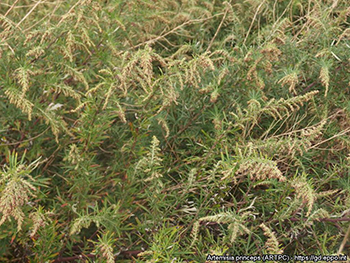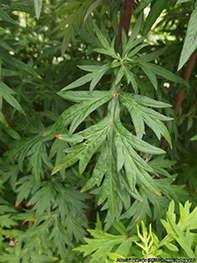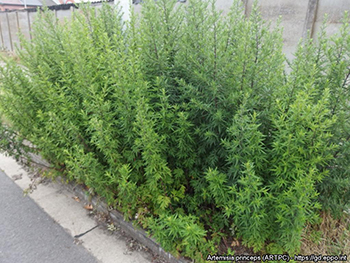
EPPO Alert List – Artemisia princeps (Asteraceae)
Why
Artemisia princeps was first observed in the EPPO region in 2011 in the Antwerp port area in Belgium. Since then, it has been recorded from several additional locations in Belgium and the Netherlands where it can form large monospecific stands.
Geographical distribution
EPPO region: Belgium, the Netherlands.
Asia: China (native), Japan (native), Korean peninsula (native).

Inflorescences – Courtesy: Filip Verloove

Leaves – Courtesy: Filip Verloove

Ruderal habitat – Courtesy: Filip Verloove
Morphology
Stem: Erect 60–150 cm, sparsely arachnoid puberulent in upper half, glabrescent towards base.
Leaves: densely arachnoid tomentose beneath, glabrous above. Lowermost leaves long petiolate; leaf blade ovate or elliptic-ovate, 1- or 2-pinnatipartite; segments 2 pairs, oblong or oblong-elliptic. Middle cauline leaves: petiole 1– 2(– 3) cm; leaf blade ovate or ovate-elliptic, 6 –12 × 4 – 8 cm, pinnatipartite; segments 2 – 3 pairs, elliptic-lanceolate or elliptic; distal lobe and lobules of lateral lobes larger, obtuse to acute apically. Uppermost leaves pinnatipartite; leaflike bracts 3-lobed or entire.
Inflorescence: a broad panicle with divaricate, erecto-patent branches. Capitula oblong or oblong-ovoid, 1.5 – 2 mm wide × 2.5 – 3.5 mm long, sessile or shortly pedicellate. Phyllaries imbricate, in four series, the outer oblong to broadly ovate, the inner rounded, sparsely arachnoid puberulent to glabrescent. Marginal florets female, threadlike, 1.2 mm long, 5 –7 in number. Disk florets bisexual, tubular, purplish, 2 mm long, usually 4 – 9 in number (sometimes less).
Achenes: oblong, truncate at both ends, 1.5 × 0.5 mm, glabrous, seed coat loose.
Biology and Ecology
Artemisia princeps is a rhizomatous perennial herb species that in Western Europe starts to flower towards the end of August or early September.
Habitats
In Western Europe, habitats include roadsides, embankments, railway embankments, and rough ground, often in port areas, between 0 and 20 m altitude. In the native range in China, A. princeps is found along roadsides, forest margins and riverbanks and on slopes and shrub land, between 100 and 1400 m altitude.
Pathways for movement
In Asia, A. princeps is utilised for a number of purposes including medicinal purposes, and as a culinary herb. The species may have been introduced into the region for these purposes or, as the species is found near entry points (ports), it could have arrived as a contaminant of goods.
Impacts
In Belgium and the Netherlands, the species has been shown to form large monospecific stands and is capable of spreading via rhizomes and seed.
Control
There is no specific information on the control of A. princeps, but as the species has long rhizomes any control programme should ensure that belowground material is removed to avoid regrowth.
Sources
Verloove F, Andeweg R (2020) Artemisia princeps L. (Asteraceae), an overlooked invasive Far Eastern weed in Western Europe. Gorteria 42, 1-18.
Verloove F, Janssens SB, Andeweg R, Zooneveld BJM, Van der Beeten I (2020) Morphological, genome-size and molecular evidence for the presence of another invasive East Asian Artemisia (Asteraceae) in Western Europe. BioInvasions Records 9(4), 685–701. https://doi.org/10.3391/bir.2020.9.4.03
